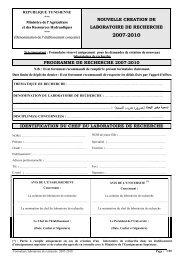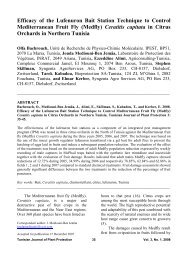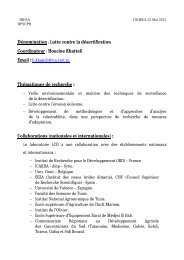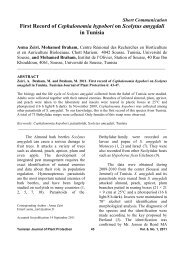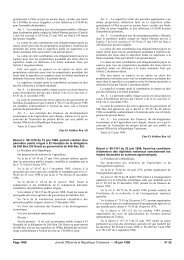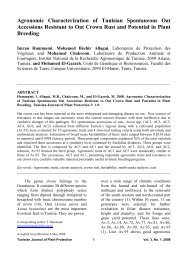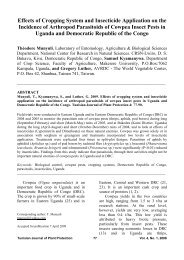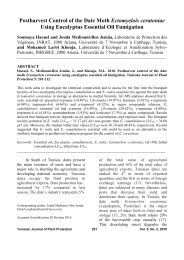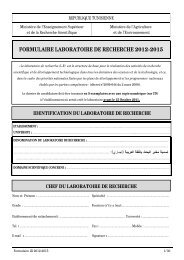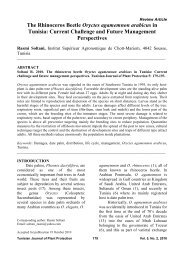Biological, Serological, and Molecular Characterization of ... - Iresa
Biological, Serological, and Molecular Characterization of ... - Iresa
Biological, Serological, and Molecular Characterization of ... - Iresa
Create successful ePaper yourself
Turn your PDF publications into a flip-book with our unique Google optimized e-Paper software.
in Mediterranean area (12, 30). These<br />
Tobamoviruses causing Pepper mild<br />
mottle virus (PMMoV) disease have been<br />
ordered on the basis <strong>of</strong> their interaction<br />
with the L gene for resistance in pepper<br />
genotype. Based upon their ability to<br />
overcome the resistance conferred by<br />
allelic series <strong>of</strong> Capsicum spp. genes<br />
known as L 1 , L 2 <strong>and</strong> L 3 they have been<br />
designed as pathotypes P 1 , P 1,2 ,<br />
respectively (11). In the Capsicum genus,<br />
four alleles <strong>of</strong> the Tobamovirus resistance<br />
gene L have been discovered. The allele<br />
L 4 confers resistance to the more<br />
aggressive pathotype PMMoV 1,2,3 which<br />
was originally found in some lines <strong>of</strong><br />
Capsicum chacoense <strong>and</strong> was introduced<br />
in the Hungary pepper type “Himes F1”<br />
(24).<br />
In the last five years, severe necrosis<br />
on fruits <strong>and</strong> mottling on leaves similar to<br />
those caused by Tobamoviruses have<br />
been observed on the J27 F1 resistant<br />
hybrid cultivated in the central coastal<br />
area. Paying attention to these<br />
observations, we attempt in our study to<br />
identify <strong>and</strong> characterize this virus using<br />
biological, serological, <strong>and</strong> molecular<br />
tools. Host ranges, serological <strong>and</strong><br />
molecular reactions <strong>of</strong> these isolates were<br />
compared to those <strong>of</strong> reference isolates.<br />
MATERIALS AND METHODS<br />
Virus isolates <strong>and</strong> strains. Two virus<br />
isolates Sah.11-00 <strong>and</strong> Teb.24-00 were<br />
taken in this study with reference isolates<br />
<strong>of</strong> four strains belonging to the<br />
Tobamovirus group, kindly supplied by<br />
Gebre-Selassie from INRA Avignon-<br />
France (1998). They are described in<br />
Table 1. The studied isolates were<br />
collected from J27 pepper hybrid plants<br />
grown under cold plastic tunnels during<br />
early season crop 2000/2001 in two<br />
regions Teboulba <strong>and</strong> Sahline situated in<br />
central coastal area <strong>of</strong> Tunisia. Severe<br />
Table 1. Strains <strong>and</strong> isolates used in this study<br />
Isolates Original host Country Authors<br />
ToMV: SM2 Tomato France Messiaen <strong>and</strong> Maison, 1964 (21)<br />
TMV: Vi 76 Pepper France Gebre-Selassié <strong>and</strong> collaborators (12)<br />
PMMoV (1-2): Adam Pepper France Gebre-Selassié <strong>and</strong> collaborators (12)<br />
PMMoV (1-2-3): Eve Pepper France Gebre-Selassié <strong>and</strong> collaborators (12)<br />
Sah.11-00 Pepper Tunisia This work<br />
Teb.24-00 Pepper Tunisia This work<br />
necrotic symptoms on fruits <strong>and</strong> mottling<br />
have been observed on leaves <strong>of</strong> J27<br />
infected plants. All reference <strong>and</strong> local<br />
isolates were long-term stored by<br />
desiccation <strong>of</strong> small amounts <strong>of</strong> leaf<br />
materials <strong>of</strong> pepper over calcium chloride<br />
(CaCl 2 ) at 4°C according to the method<br />
described by Bos (3).<br />
<strong>Biological</strong> tests. Fresh collected or<br />
calcium chloride conserved dried leaves<br />
were ground in 0.03 M phosphate buffer<br />
(pH 7.2) <strong>and</strong> containing 0.2% Sodium<br />
diethyldithiocarbamate (Na-DIECA) at<br />
the rate 1:4. Activated charcoal (75<br />
mg/ml buffer) <strong>and</strong> celite were added to<br />
the extract. Inoculation was made by<br />
rubbing the extract on 5-leaf stage plants<br />
for each isolate tested. The isolates were<br />
cloned after two successive passages on<br />
Nicotiana glutinosa. A single local lesion<br />
was used to propagate the virus in each<br />
time. Virus cultures were maintained in<br />
Tunisian Journal <strong>of</strong> Plant Protection 2<br />
Vol. 1, No. 1, 2006




